The Different Types of Hairlines for Men and Women
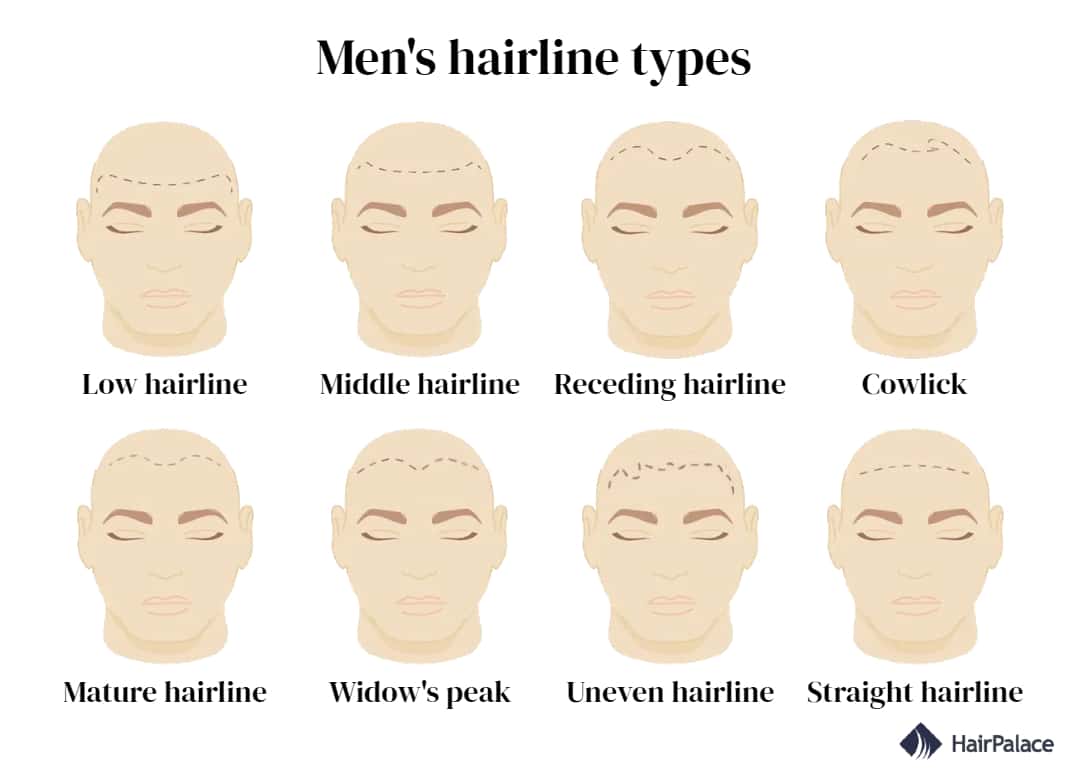
Men’s hairlines commonly include straight hairlines, receding hairlines, and widow’s peaks with a distinct V-shaped point.
Women’s hairlines typically feature rounded hairlines with smooth curves, high hairlines set farther back on the forehead, and widow’s peaks similar to those in men.
These variations can be influenced by genetics, age, and hormonal changes.
However, you may be able to adjust yours if you’re unhappy with it.
How many different types of hairlines are there? And what can you do to alter yours?
We’ll answer these and other key questions below.
- What it is
- Men’s hairline types
- Women’s hairline types
- Maintenance
- How to change yours
- Speak to a doctor
What is a hairline?
Your hairline marks the edge of the region where hair growth occurs. A normal hairline starts at your forehead, outlining your hair.
Different types of hairlines are defined by factors such as shape, height, and hair growth, playing a vital role in our overall appearance.
Your hairline type is likely to change throughout your life as you start to lose hair with age. Furthermore, men and women have different types of hairlines.
8 different types of mens hairline
The following factors determine all hairline types:
- Hormones
- Genetics
- Age
- Lifestyle
Men and women can have the same shapes, but men may undergo a significantly more drastic change due to one or more of these factors.
Here are the 8 most common male hairline types:
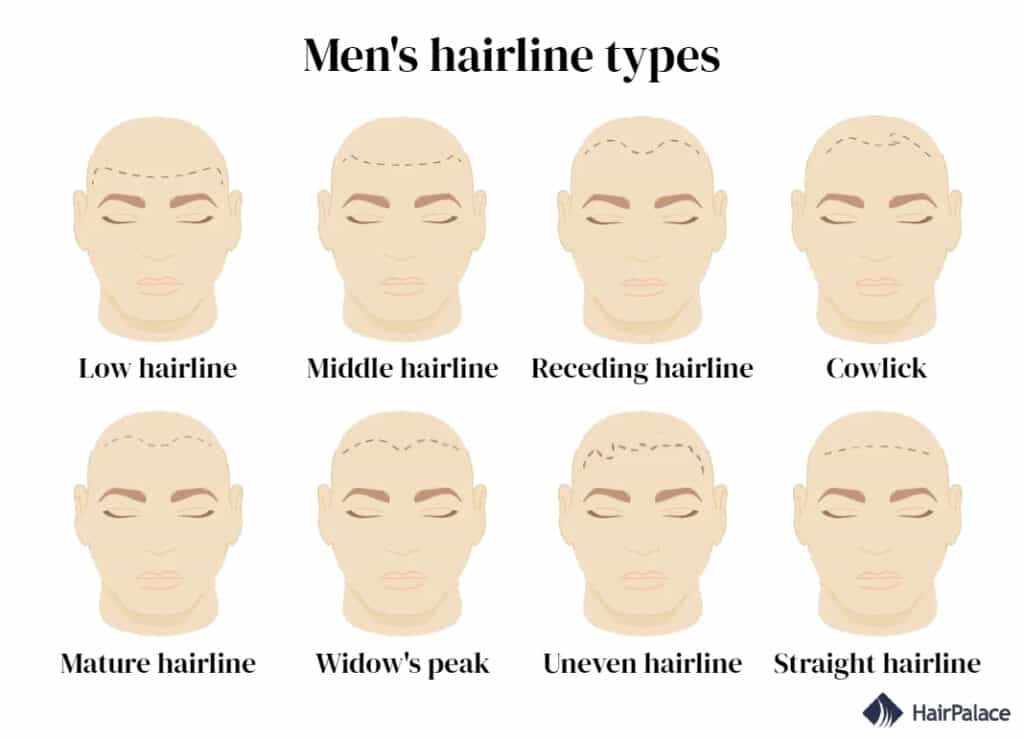
1. Low hairline
Men typically have low hairlines throughout their childhood and well into their teens, before they start to lose any hair.
This is known as a juvenile hairline when it runs in a straight line.
Low hairlines begin closer to a man’s eyebrows and can make the forehead look smaller. Some men may retain a low frontal line for longer than others.
2. Middle hairline
A middle hairline typically looks more proportionate to the forehead. Men may start to develop a middle hairline during their teenage years and in their twenties.
This type of men’s hairline can look different from person to person: it could be asymmetrical, rounded, or straight.
3. High or mature hairline
Your hairline is considered high if it starts on the crown of your head.
This type of men’s hairline is usually caused by genetics, though it may also be due to hair loss or thinning hair.
4. Receding hairline
Men may develop a receding hairline at any time following puberty, and they can resemble high hairlines as they continue to reveal more of the scalp.
This is also referred to as an M-type hairline as a receding hairline may look like an “M” if excessive shedding occurs around the temples. M-shaped hairlines are a common result of male pattern baldness.
It is usually hereditary, so if receding hairlines are common in your family, it’s likely you’ll develop one.
Pattern baldness is caused by the sex hormone dihydrotestosterone (DHT), which shrinks follicles on the scalp leading to a general thinning.
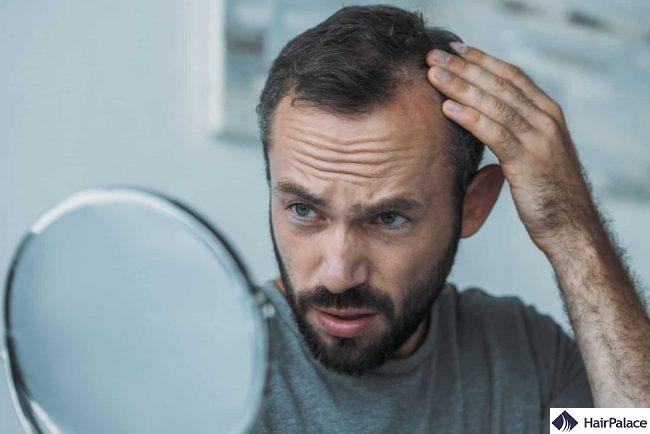
5. Cowlick
A cowlick is a section of hair growing in an opposing pattern to the hairs around it.
This may form in any area of the scalp, but cowlicks are particularly common at the hairline and crown.
You may be more likely to have a cowlick if you have short hair, and they can affect men and women alike.
If you want to make your cowlick less visible, speak to your hairstylist. They should be able to recommend a few tricks to tame it.
6. Widow’s peak
A widow’s peak has a V-shape, and may look more or less noticeable as you age.
This hairline type is characterized by forming two distinct bald patches at the temples.

7. Uneven hairline
Asymmetrical hairlines are common, though their form varies.
One side may appear slightly higher than the other, or the whole frontal line could zig-zag drastically.
Uneven hairlines may be caused by genetics or excessive styling, such as wearing the hair in a tight ponytail.
8. Straight hairline
Juvenile, rectangular, or straight hairlines run neatly across the forehead.
The 9 types of hairlines in women
Not only can a great-looking hairline boost our self-confidence and improve our appearance, but it can also gauge how healthy our hair is currently.
So when our hairline isn’t looking its best, it can understandably be a cause for concern.
No doubt your confidence is knocked as you try to work out what’s causing the changes.
Different types of hairline male and female variants are radically different.
However, the types of hairline shapes are determined by the same factors in both sexes.
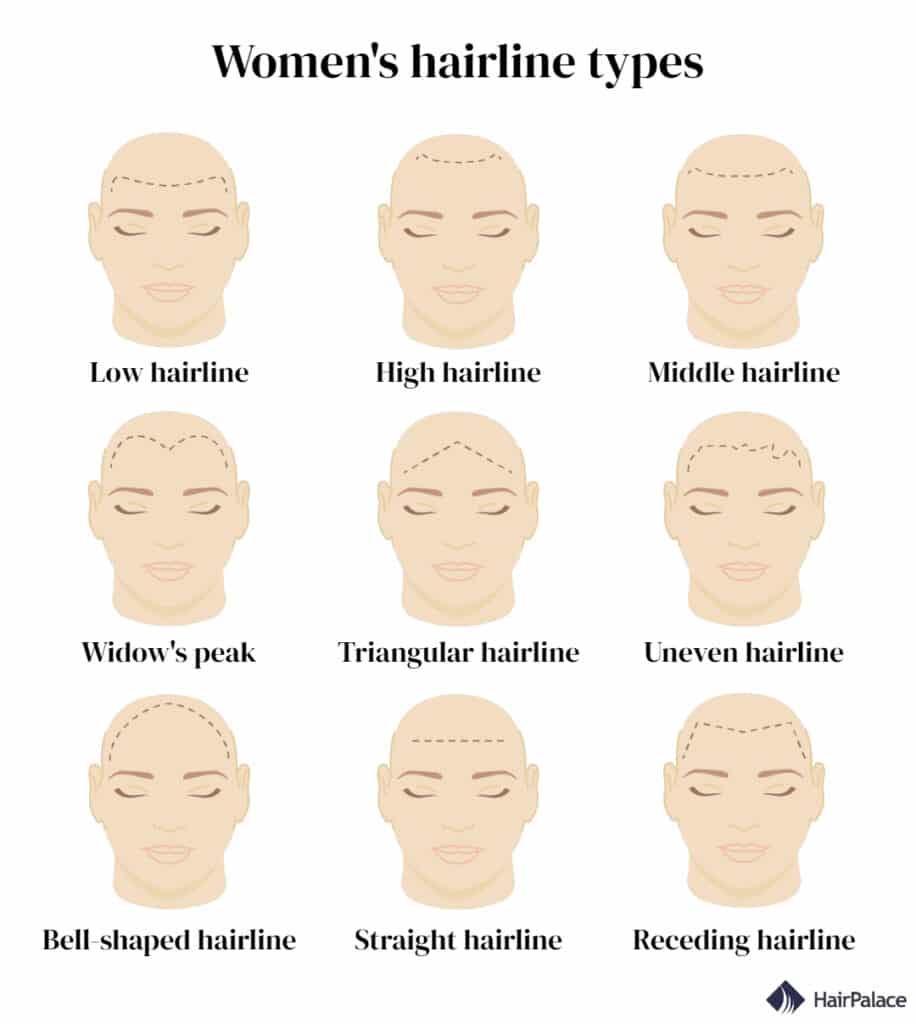
A woman’s hairline can change for several reasons. Below, we explore 9 of the most common types you may experience:
1. Low hairline
A low hairline sits quite close to your eyebrows. Your forehead will appear narrower and shorter as a result.
The benefit of this type of hairline is that women are less likely to develop a receding frontal line.
2. High hairline
On the other hand, if your hair starts from higher above your forehead, you have a high hairline.
It largely stems from genetics, and no doubt other women in your family will have a similar one.
That said, some women may develop a high hairline due to alopecia.
3. Middle hairline
Also known as the “average” or” normal hairline,” the middle hairline is the most common type of hairline for men and women.
As its name suggests, it sits just in the middle of the forehead.
This versatile hairline allows you to style hair in many ways, for both men and women; it sits just in the middle of the forehead.
4. Widow’s peak
A widow’s peak is a pointed hairline where your hair forms a distinctive V shape in the center of the forehead.
This can develop because of your genetics; often, someone in your family may have already experienced this hair loss.
5. Triangular hairline
This is an inverted widow’s peak, starting lower at the temples and gradually rising to a central point on your forehead.
It can be quite angular in appearance, which is why it’s often called a triangular hairline.

Sometimes, a triangular hairline results from hair loss conditions such as temporal triangular alopecia (congenital triangular alopecia).
Although the root causes are still unknown, scientists suggest a strong link between genetics and developing the condition.
6. Uneven hairline
If you examine hairlines closely, you will notice that many are asymmetrical (the two sides do not match exactly). Sometimes, one side might be higher than the other.
Again, there’s a strong link between genetics and an uneven hairline, though other causes may include physical trauma to hair, harsh hair styling practices, or conditions like female pattern baldness.
7. Bell-shaped hairline
A bell-shaped hairline is round in shape and often looks like an upside-down U.
Both sides will be symmetrical to one another, and the edges will be curvy.
This can develop naturally or as a result of a receding hairline and may make your forehead appear much longer than it actually is.
8. Straight hairline
As the name suggests, a straight hairline will run directly across your forehead and will not follow the natural curve of your head.
Straight frontal lines are often a result of genetics, though some men and women style and cut their hair to achieve this look.
9. Receding hairline
Although more commonly found in men, women may still experience a receding hairline in certain circumstances.
This usually presents itself as an M-shaped hairline along your forehead.
It is quite often a result of hormonal changes in the body, such as pregnancy and menopause, genetics, suffering from increased amounts of stress, or lifestyle choices.
Some causes of receding hairline in women are easily avoidable.
For instance, tight hairstyles can cause unnecessary trauma and physical strain on your hair (known as traction alopecia), which may lead to permanent hair loss.
Other things to consider may include the types of shampoos, conditioners, and hair dyes you use.
If they contain harsh chemicals, this can further damage and recede your hairline.
Maintaining your hairline
1. Scalp massage
A scalp massage can help protect, strengthen and stimulate hair growth across your entire head.
Although research is still ongoing, some studies have found that even just 4 minutes of daily massage can make a difference in stimulating more hair growth.
Scalp massages improve blood circulation in the scalp, allowing for more food and nutrition to arrive at hair follicles.
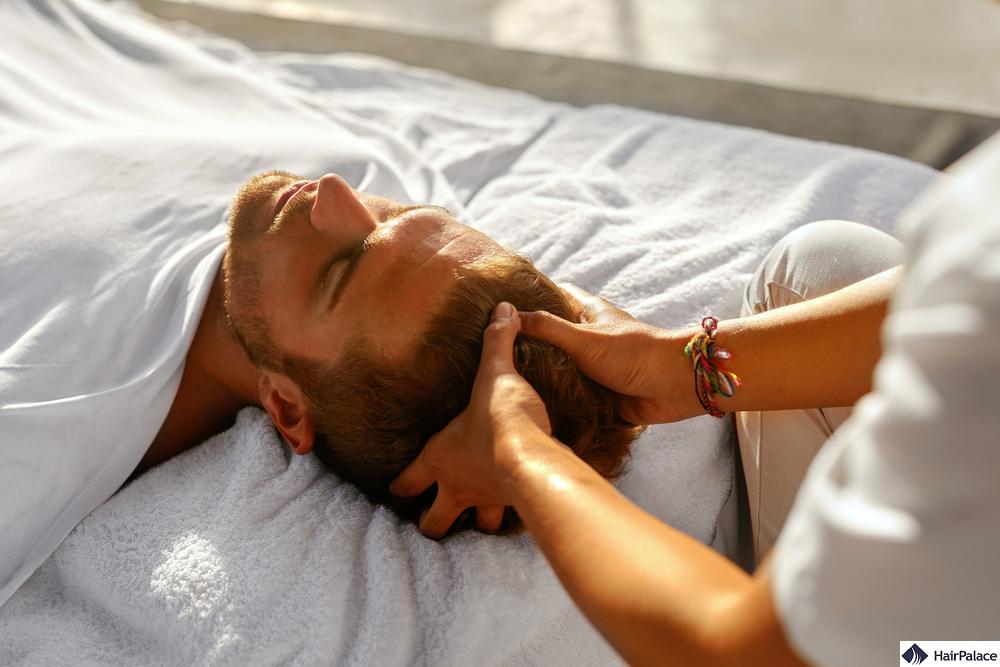
2. Moisturize your hair
When our scalp is dry, it is more prone to damage and irritation. For that reason, you should try to keep your head moisturized.
Hydrating shampoos and conditioners can help.
You should also avoid using heat-styling techniques like hair straighteners, as these can dehydrate the follicles instantly.
3. Choose the right shampoo for your hair
Shampoos are some of the best ways to support your hair, improve its health, and protect it from potential damage.
Choose products that have anti-hair fall properties, as these contain ingredients that help your hair and won’t damage it further.
It stands to reason that you should avoid any products with harsh chemicals, as these can further irritate your hair and skin.
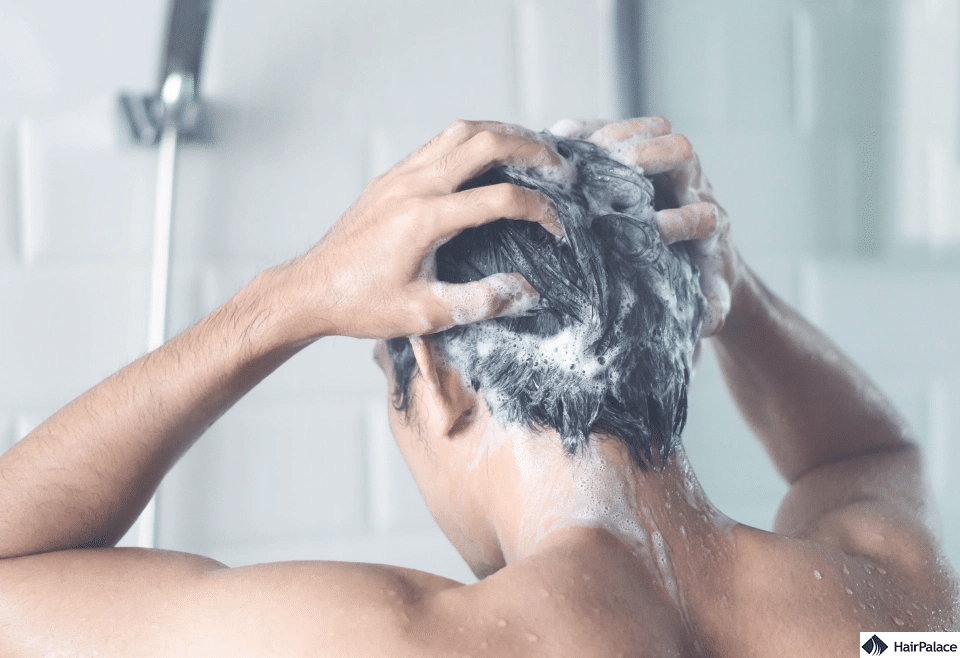
4. Use a hair mask
A hair mask is a useful way of supporting and nourishing your hair. It’s a deep-conditioning treatment that travels inside the hair’s cuticle.
Keratin-based hair masks often work the best, leading to softer, healthier hair and helping to boost blood circulation, stimulating further growth.
You should use a hair mask at least once a week for optimal results.
5. Healthy diet
You cannot expect your hair to stay firm and healthy if you don’t provide proper nutrition.
In fact, nutritional deficiencies can be one of the contributing factors to your hair loss in the first place!
Thankfully, this can be easily solved by eating more healthily.
Opt for foods rich in essential vitamins and minerals, including biotin, protein, zinc, and fatty acids.
These will help support existing hair and help promote new growth, too.
These essential nutrients are found in various fruits, vegetables, and meats. But if you are struggling to increase your daily intake of them, you may consider taking supplements.

6. Avoid tight hairstyles
As we’ve said, tight hairstyles can cause unnecessary but significant physical trauma to your hair, constantly pulling it out of place and adding pressure to hair follicles.
Avoid putting your hair into tight braids, cornrows, buns, and tight ponytails, as these hairstyles will often pull at your hair roots.
How can I change my hairline?
If you want to alter yours, you have several options to choose from:
Hair removal
Electrolysis or laser hair removal treatments can raise your hairline if you feel it’s too low, or if you have a widow’s peak.
Hair-styling techniques
You may be able to change the way your hair looks with various cuts or styling tricks. This can be a more comfortable and convenient solution than wearing a hat each day.
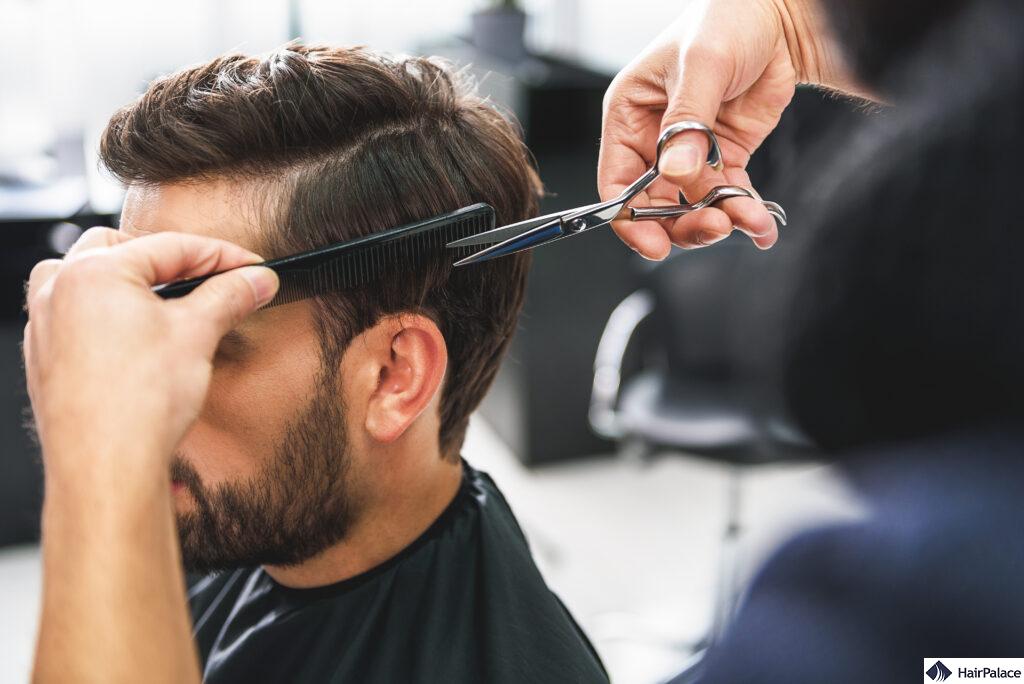
Plucking
If you want to straighten out your asymmetrical hairline or widow’s peak, you can pluck hairs carefully with a pair of tweezers. However, this can be time-consuming and painful.
Shaving
Some men shave their scalp fully bald when their hair recession becomes too difficult to disguise.
Microblading
This temporary hair tattooing process recreates the appearance of individual hairs. Results should last between 6 and 18 months.
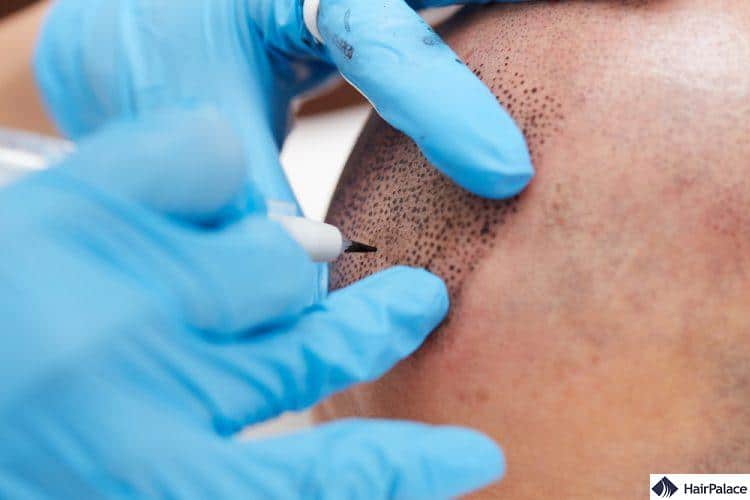
Medication
Some medications (such as Finasteride and Rogaine) can treat receding hairlines, though corticosteroids and Dritho-Scalp (intended for psoriasis) may work too.
However, medications can trigger side effects so discuss them with your doctor first.
They’ll help you understand the causes of your hair loss and what you can expect from your chosen treatment.
Hair transplant
Hair transplants, such as Follicular Unit Extraction (FUE), are increasingly common among men and women.
The concept of hairline transplants is simple: a surgeon removes healthy hair follicles from the sides or back of the head under a local anaesthetic.
They then transplant these into the frontal line to create a fuller, more even shape.
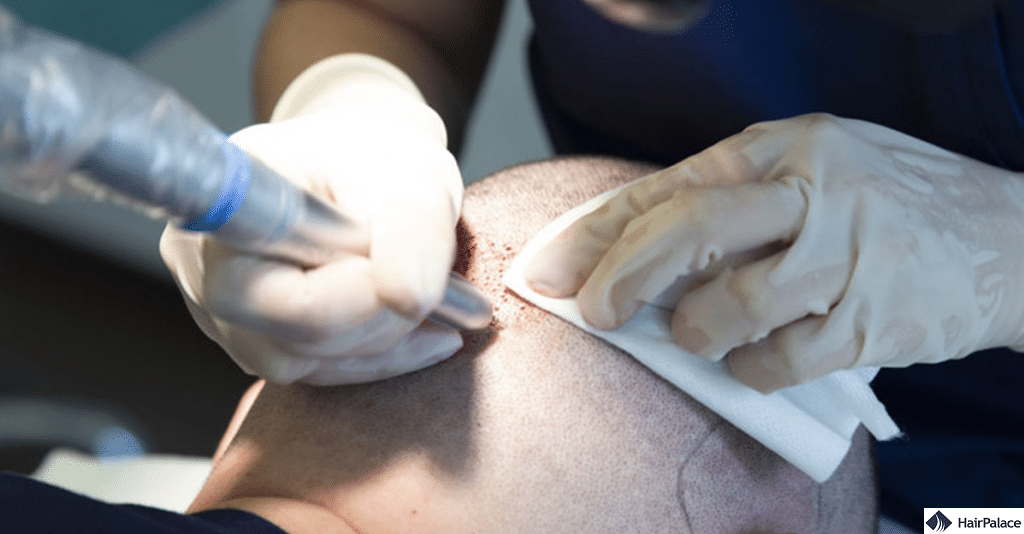
Speak to your doctor about your options
Contact your doctor if you want to discuss options for changing your hairline.
Many men find hair loss difficult to accept, but your doctor should be able to identify the reasons for your hair thinning and advise you on potential treatments.
Various medications are connected with hair thinning, including specific kinds of antibiotics, drugs formulated to reduce cholesterol, and acne treatments.
Tell your doctor if you take one or more of these medication types, or any other. Alternatives that have no effect on hair may be available.
Also, let your doctor know if you feel stressed, as this can make hair loss worse.
Taking the next step to change your hairline
A hair transplant is the most effective way to alter your hairline. A surgeon can bring it lower and straighten it out for a more youthful, consistent shape.
Additional transplantation can be performed on the crown or any other areas affected by thinning.
HairPalace provides cutting-edge hair transplants that achieve 90 – 95% success rates.
FAQ
Middle hairlines (otherwise known as normal or average hairlines) appear to be the most common type, though there’s no credible data on the subject. Middle hairlines grow across the centre of the forehead.
A hairline receding back onto the scalp can indicate balding, especially if it takes on an M-shape or widow’s peak. With the former, the M-shape develops because the round curves of the more youthful hairline fade and the shape becomes distinctive. A widow’s peak is a V-shape, with the centre at a lower point than the rest.
If you want to examine yourself for recession, you can check the corners, your crown, and other areas while styling your hair. When one or more areas appear thinner than others, that could be an early sign of an impending receding hairline.
An uneven hairline is common. Many people have an asymmetrical face and body, too, which usually occurs as a natural part of growth.
Consider using Minoxidil (Rogaine), seeking FDA-approved treatments, and consulting with a dermatologist or hair restoration specialist.
To fix your hairline consider consulting a dermatologist or trichologist. These specialists will give you an accurate diagnosis and come up with the appropriate treatment plan.
The homozygous dominant genotype for a widow’s peak hairline is “WW”.
Last medically reviewed on July 19th, 2024
- Beek CH. A study on extension and distribution of the human body-hair. Dermatologica. 1950;101:317–31. https://pubmed.ncbi.nlm.nih.gov/14802145
- Hamilton JB. Patterned loss of hair in man: Types and incidence. Ann N Y Acad Sci. 1951;53:708–28.https://pubmed.ncbi.nlm.nih.gov/14819896
- Norwood OT. Male pattern baldness: Classification and incidence. South Med J. 1975;68:1359–65https://pubmed.ncbi.nlm.nih.gov/1188424
- Hong H, Ji JH, Lee Y, Kang H, Choi GS, Lee WS. Reliability of the pattern hair loss classifications: A comparison of the basic and specific and Norwood-Hamilton classifications. J Dermatol. 2013;40:102–6https://pubmed.ncbi.nlm.nih.gov/23110308
- Sirinturk S, et al. (2016). Study of frontal hairline patterns for natural design and restoration.https://doi.org/10.1007/s00276-016-1771-1


